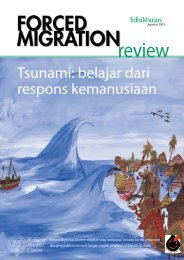FMR 42 full issue pdf - Forced Migration Review
FMR 42 full issue pdf - Forced Migration Review
FMR 42 full issue pdf - Forced Migration Review
Create successful ePaper yourself
Turn your PDF publications into a flip-book with our unique Google optimized e-Paper software.
<strong>FMR</strong> <strong>42</strong><br />
Sexual orientation and gender identity and the protection of forced migrants 45<br />
Certain refugee resettlement sites are more<br />
experienced at integrating comprehensive<br />
services, and are better prepared to make<br />
appropriate referrals or to accommodate special<br />
medical or mental health needs internally. One<br />
model for LGBT refugee resettlement parallels<br />
that used for refugees living with HIV in the<br />
1990s, in which specific agencies were equipped<br />
to manage the health needs of people living<br />
with HIV/AIDS while maintaining rigorous<br />
standards of confidentiality. 4 Resettlement<br />
agencies serving LGBT refugees may also<br />
be able to incorporate lessons learned from<br />
torture treatment programmes, which typically<br />
emphasise specialised trauma-informed<br />
mental health services, offer services over<br />
a longer period of time, and employ a team<br />
approach that enables survivors to obtain<br />
services without having to retell their story or<br />
disclose their identity to multiple providers. 5<br />
Transgender refugees are best resettled in<br />
preferred sites where agencies have prior<br />
expertise and pre-existing linkages with<br />
LGBT-specific service providers. Transgender<br />
refugees face profound difficulties in obtaining<br />
specialised medical care, supportive and safe<br />
housing, and appropriate employment. Another<br />
emerging best practice is to link LGBT refugees<br />
with sponsors, either in the LGBT community<br />
or among straight allies, who can assist in<br />
meeting initial needs and provide the sense<br />
of social support that LGBT refugees who are<br />
isolated from their own communities require. 6<br />
Mainstreaming LGBT resettlement<br />
Given the small number of self-identified LGBT<br />
refugees and the great number who do not<br />
disclose, it is important for all refugee service<br />
providers to create a safe and supportive<br />
environment and to foster tolerance within the<br />
wider community. Mainstreaming involves<br />
integrating LGBT-appropriate services within<br />
existing practices, based on the knowledge that<br />
any refugee may be LGBT and that uniform<br />
standards for access, respectful communication<br />
and protection need to be provided regardless<br />
of whether any refugees disclose information<br />
about sexual orientation or gender identity.<br />
This mainstreaming of LGBT-appropriate<br />
services includes simple steps, such as making<br />
sure that multilingual brochures and posters<br />
are displayed on site, displaying a rainbow<br />
flag or symbol 7 to demonstrate openness to<br />
conversations about sexual orientation or gender<br />
identity, and ensuring that staff members<br />
are conscious of the adverse effects of jokes,<br />
derisive or inappropriately gendered language,<br />
and stereotyping. Mainstreaming includes<br />
ensuring that appropriate anti-discrimination<br />
and grievance policies exist, and ensuring<br />
that these policies are understood by and<br />
accessible to programme participants. 8<br />
Mainstreaming also extends to communication<br />
with refugees within the agency and immigrant<br />
communities externally. Practitioners should<br />
integrate information on sexual orientation and<br />
gender identity within broader conversations<br />
on diversity and cultural differences in the<br />
US, in order to avoid separating out and<br />
stigmatising LGBT refugees. There are two<br />
forums in which resettlement agencies have<br />
clear opportunities to educate refugees on<br />
diverse expressions of sexuality and gender.<br />
Cultural orientation – conducted within the<br />
first 30 days of arrival – offers a chance to<br />
dispel prevalent myths surrounding the LGBT<br />
community and promote acceptance. Careful<br />
introduction of gender roles, including sexual<br />
orientation, into discussions of parenting can<br />
mitigate the risk of violence against LGBT or<br />
gender non-conforming young people. ESL<br />
classes present another opportunity; although<br />
ESL instructors may prioritise language<br />
acquisition for employment purposes, English<br />
classes can also serve as extended cultural<br />
adjustment sessions. Staff must be cautious and<br />
introduce these topics delicately so as not to<br />
shame refugees for their beliefs or appear to be<br />
undermining their religious and cultural mores.<br />
Recruiting ‘ally ambassadors’ within the<br />
refugee community is a powerful technique<br />
to effect positive change. Within each refugee<br />
community, one can usually find individuals<br />
sympathetic to the plight of LGBT refugees,<br />
even among nationalities or cultures which<br />
are generally highly averse to conversations<br />
about sexual orientation or gender identity.<br />
Prime candidates are young adults who,<br />
based on their English proficiency and




